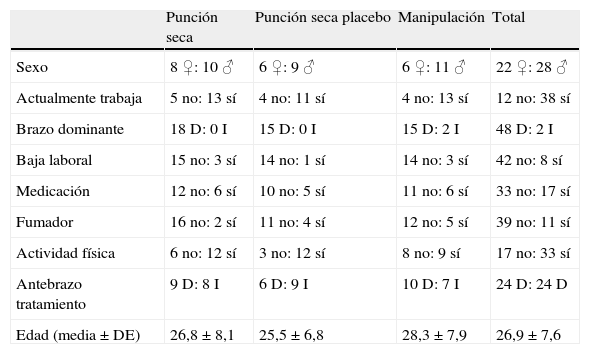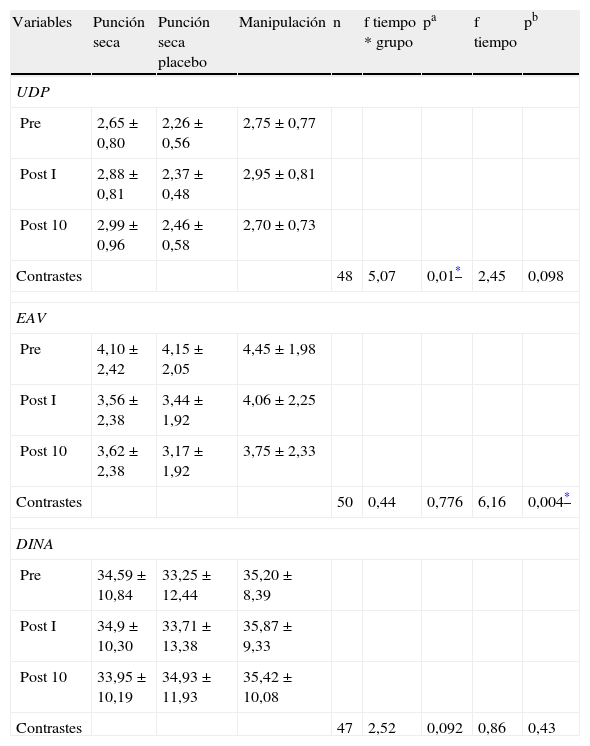Comparar el efecto provocado por la aplicación de manipulación de codo, punción seca o punción seca placebo sobre el umbral de dolor a la presión (UDP), la intensidad subjetiva de dolor y la fuerza de agarre en sujetos con punto gatillo miofascial (PGM) latente en la musculatura epicondílea.
Material y métodosSe seleccionó a 52 participantes (26,9±7,6 años) con PGM latente en la musculatura epicondílea; 50 sujetos se integraron en el estudio controlado, doble ciego y aleatorizado. Se utilizó un algómetro para la medición de UDP, una escala analógica visual (EAV) para la intensidad subjetiva de dolor y un dinamómetro de mano para la fuerza máxima de prensión. Todo ello en 3 momentos de medición: preintervención, post-intervención y transcurridos 10 min. El análisis estadístico se realizó mediante un ANOVA mixto, p ≤ 0,05.
ResultadosLos datos obtenidos mostraron un efecto significativo de la interacción grupo y tiempo para el UDP (p=0,01). Se produjo una disminución del UDP significativa (p=0,02) a los 10 min de la intervención comparado con el valor obtenido inmediatamente tras la intervención en el grupo manipulación. Para la variable del dolor medido mediante la EAV se observó un efecto significativo del factor tiempo (p=0,004).
ConclusionesNo se ha podido demostrar que la manipulación o la punción seca resulten superiores a la punción placebo en beneficios sobre el dolor, el UDP y la respuesta de fuerza de agarre en mano,
To compare the effect caused by a single application of elbow manipulation, dry needling and sham dry needling on pain and grip strength threshold (PPT) on subjects with latent myofascial trigger point (MTP) in the lateral epicondyle musculature.
Material and methodsA total of 52 participants (26.9±7.6 age) with latent MTP in the epicondyle musculature were enrolled. Fifty subjects were integrated in the double blind, randomized and controlled study. An algometer was used to measure PPT, Visual Analogue Scale (VAS) to measure the subjective intensity of pain and hand dynamometer to measure maximum grip strength. Three different points in time were measured: pre-intervention, post-intervention and 10minutes following the intervention. The statistical analysis was performed by a mixed ANOVA using P≤.05.
ResultsStatistical analysis showed a significant effect for group per time interaction for the PPT (P=.01). Post-hoc tests showed a significant decrease of the PPT (P=.02) 10 minutes after the intervention compared to the post-intervention value for the manipulation group. Subjective pain measured by the VAS showed a significant effect for the time factor (P=.004).
ConclusionsIt was not possible to demonstrate that manipulation or dry needling is superior to placebo puncture in benefits on pain, PPT and handgrip strength.
Artículo
Si ya tiene sus datos de acceso, clique aquí.
Si olvidó su clave de acceso puede recuperarla clicando aquí y seleccionando la opción "He olvidado mi contraseña".Comprando el artículo el PDF del mismo podrá ser descargado
Precio 19,34 €
Comprar ahora












